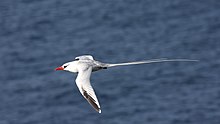Tropic Bird
| Tropicbirds Temporal range: Early Eocene to present |
|
|---|---|
 |
|
| Red-billed tropicbird (Phaethon aethereus mesonauta) | |
| Scientific classification | |
| Kingdom: | Animalia |
| Phylum: | Chordata |
| Class: | Aves |
| Clade: | Eurypygimorphae |
| Order: |
Phaethontiformes Sharpe, 1891 |
| Family: |
Phaethontidae Brandt, 1840 |
| Genus: |
Phaethon Linnaeus, 1758 |
| Species | |
|
3, see text |
|
3, see text
Tropicbirds are a family, Phaethontidae, of tropical pelagic seabirds. They are the sole living representatives of the order Phaethontiformes. For many years they were considered part of the Pelecaniformes, but genetics indicates they are most closely related to the Eurypygiformes. There are three species in one genus, Phaethon. The scientific names are derived from Ancient Greek phaethon, "sun". They have predominantly white plumage with elongated tail feathers and small feeble legs and feet.
Tropicbirds were traditionally grouped in the order Pelecaniformes, which contained the pelicans, cormorants and shags, darters, gannets and boobies and frigatebirds; in the Sibley–Ahlquist taxonomy, the Pelecaniformes were united with other groups into a large "Ciconiiformes". More recently this grouping has been found to be massively paraphyletic (missing closer relatives of its distantly related groups) and split again.
Microscopic analysis of eggshell structure by Konstantin Mikhailov in 1995 found that the eggshells of tropicbirds lacked the covering of thick microglobular material of other Pelecaniformes. Jarvis, et al.'s 2014 paper "Whole-genome analyses resolve early branches in the tree of life of modern birds" aligns the tropicbirds most closely with the sunbittern and the kagu of the Eurypygiformes, with these two clades forming the sister group of the "core water birds", the Aequornithes, and the Metaves hypothesis abandoned.
...
Wikipedia
